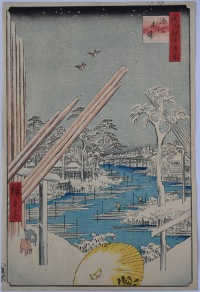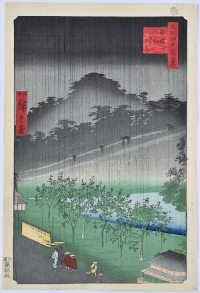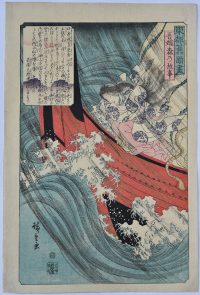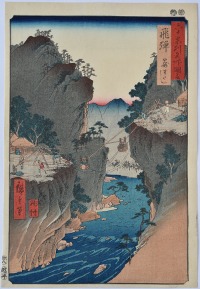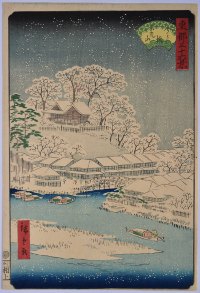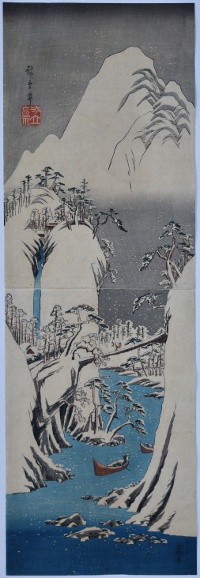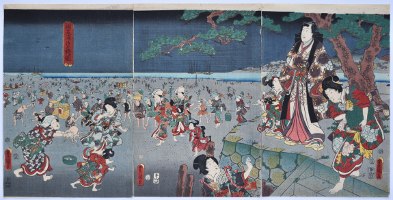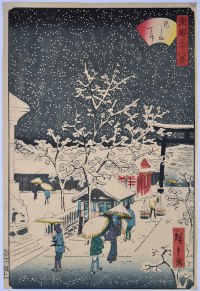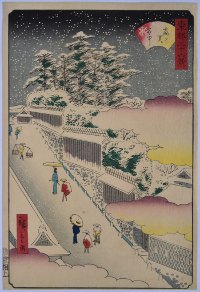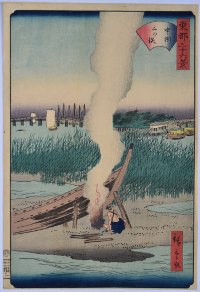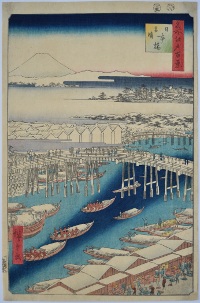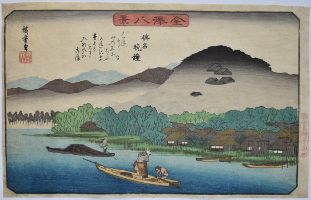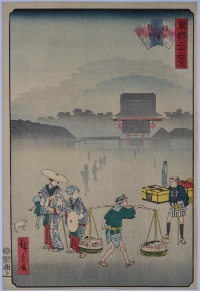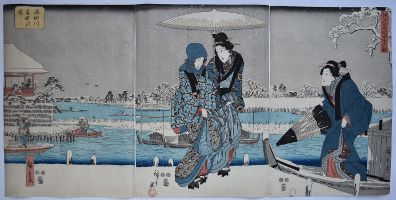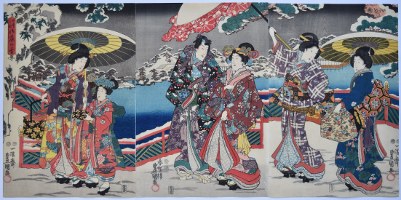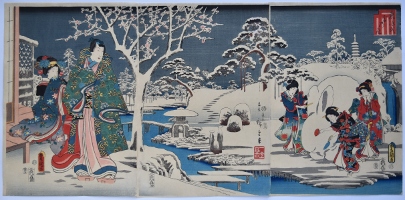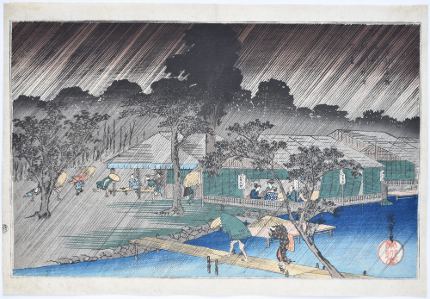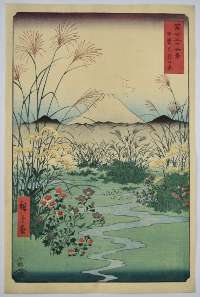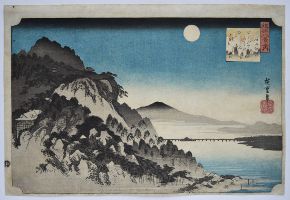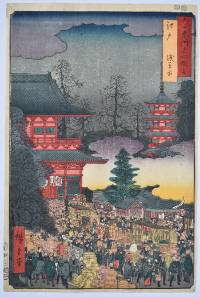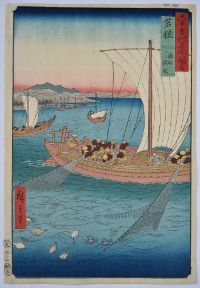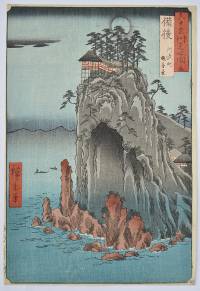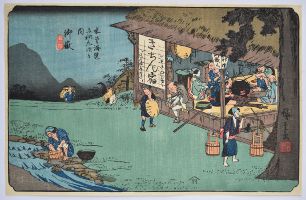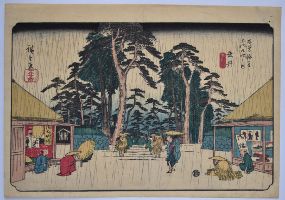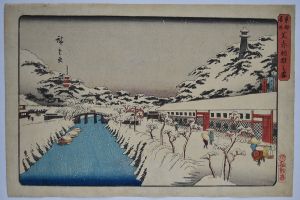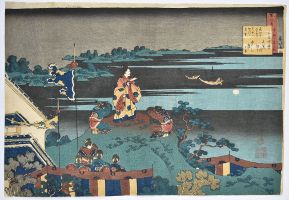Utagawa HIROSHIGE (1797-1858)
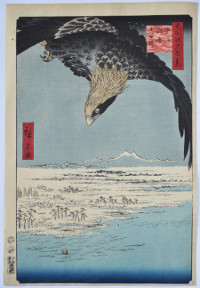
Click here to view image full size.
Fukagawa, Suzaki, juman-tsubo, “The One Hundred Thousand Tsubo Plain, Suzaki, Fukagawa” from Meisho Edo hyakkei, “One Hundred Famous Views of Edo.” The set published by Uoya Eikichi between 1856 and 1859 (this being 1857). An eagle hovers over the snowy coastal plain, Mt Tsukuba and the Chiba mountains in the distance.
Very good impression, colour and condition. Signed Hiroshige ga.
Status: Sold
Ichiryusai HIROSHIGE (1797-1858)
Click here to view image full size.
The Lumberyard, Fukagawa, from Meisho Edo hyakkei, “The Hundred Views of Famous Places in Edo.” Shows snow falling on the timber yards lining a river. An umbrella in the foreground is inscribed Uo, “Fish” – a reference to the publisher Uoya Eikichi who published the set between 1856 – 1858 (this being 1856). There are 118 prints in the set plus a replacement design by Hiroshige II (see elsewhere on this update). A large supply of timber was needed for the world’s largest wooden city. However, in 1641 a fire destroyed not only houses but the lumber which was then stored in a central area causing the government to move the yards to Fukagawa.
Very good early impression (later editions have a dark sky). Very good colour and condition. Signed Hiroshige ga.
Status: Sold
Utagawa HIROSHIGE II (1826-1869)
Click here to view image full size.
Akasaka kiribatake uchu sekikei, “Evening View of the Paulownia Grove at Akasaka in the Rain.” The replacement print for the Meisho Edo hyakkei “The Hundred Views of Famous Places in Edo” after 1858 probably because the blocks were damaged, and a superior design to Hiroshige’s. Published by Uoya Eikichi, 1859.
Very good impression. (The same impression as is illustrated in Ukiyo-e Taikei, XVI, 48-2.) Fine colour. Very small binding holes in margin, otherwise fine condition. Signed Nisei (the second) Hiroshige ga.
Status: Sold
Ichiryusai HIROSHIGE (1797-1858)
Click here to view image full size.
Azuma no Mori no koji “ The Old Story of Azuma” from a set Toto kyuseki tsukushi, “Old Edo Stories, Illustrated.” Exceptionally rare: Four other designs from the set came up at the Orange and Thornicraft sale, Sothebys, 25/3/1912, lot 440. And another impression of this design is illustrated in Hiroshige, The Albuquerque Museum, 1983, no. 722, pl. 74. Shows the concubine Tachibana Hime about to throw herself from the prow of the boat to appease the sea-gods and protect her lord Yamato Take. This she did despite him vowing to marry Miyazu Hime on his return. Published by Wakasa-ya, c. 1845. A wonderful design.
Fine impression, colour and condition. Signed Hiroshige ga.
Status: Sold
Ichiryusai HIROSHIGE (1797-1858)
Click here to view image full size.
Hida. Kago-watashi, “The Basket Ferry, Hida Province” from Rokuju yoshu meisho zue, “Famous Places in the Sixty-Odd Provinces.” The set published by Koshimuraya Heisuke between 7/1853 and 3/1856 ( this being 1853 ).
Extremely fine impression of the first edition. Fine colour and condition. Signed Hiroshige ga.
Status: Sold
Ichiryusai HIROSHIGE (1797-1858)
Click here to view image full size.
A distant view of Mount Daisen [ Oyama ] in Hoki Province. One of the best designs from Rokuju yoshu meisho zue, “Famous Places in the Sixty-Odd Provinces.” The set published by Koshimuraya Heisuke between 7/1853 and 3/1856 ( this being 12/1853 ). White rain ( printed with gofun ) falls on groups of peasants planting rice. A lovely design, the edges of the paddy fields zig-zagging into the distance. This is the rare first edition with blue and yellow diagonal bands on the sub-cartouche.
Fine impression with strong woodgrain showing. The second state of the first edition has the rain printed black (not using gofun as here).Very good colour and condition. Signed Hiroshige ga.
Status: Sold
Ichiyusai HIROSHIGE II (1829-1869)
Click here to view image full size.
A snow scene: Imadobashi Matsuchiyama, “Imado Bridge and Matsuchi Hill.” From Toto sanjurokkei, “Thirty-six Views of the Eastern [ Edo ] Capital.” The set published by Ai-To between 1861 and 1862 ( this being 8/1862 ). This was also a district that attracted Hiroshige I and he designed a number of prints of the area. One of the six best designs from the set.
Fine impression of the first edition. Fine colour. Trimmed close at bottom, otherwise fine condition. Signed Hiroshige ga.
Status: Sold
Ichiryusai HIROSHIGE (1797-1858)
A vertical oban diptych, Fujigawa no setchu, “The Fuji River in Winter.” Hiroshige records in his diaries that he commenced on a journey westwards from Edo on the fourth month Tempo 12 (1842). He walked the Koshukaido to Kofu in Kai Province and then on to Shimo-suwa. On the route to Kofu, he mentions visiting the Saruhashi, Monkey Bridge, and consequently must have crossed the upper reaches of the Fuji River to reach Kofu. On his return Hiroshige designed two kakemono-e, one of the Monkey Bridge for the publisher Tsutaya, and the design here of Fujigawa for the publisher Kikakudo (Sanoya Kihei). Both are considered masterpieces. The magisterial format perfectly conveys the wild landscape with a diminutive figure crossing the bridge above the gorge with boatmen on the river. Published c. 1842-44. There are many copies of these two kakemono-e. Genuine impressions of this design should have a small vertical block defect bottom right where the mountain meets the river, just to the left of the publisher’s seal. Extremely rare.
Fine impression. The slopes of the mountain top left are printed without outline and appear different on different impressions, also because the block for the sky was changed. Fine colour (although the colour scheme is almost monochromatic relieved by only the blue of the river and touches of brown and green). Very good condition: Full size with ample room for joining of the two sheets. These designs often come heavily browned as they were hung as substitute paintings. Signed Hiroshige hitsu.
Status: Sold
Utagawa KUNISADA (1786-1865)
Click here to view image full size.
A triptych showing Prince Genji (far right) on a stone terrace looking out at Suma Beach, Akashi, thronged with visitors enjoying themselves. Two of his party look as though they are going to collect shells. A mitate of Chapter XIII of the Genji Monogatari where Genji is exiled at Akashi, Akashi no ura shiogari no zu. There was a proliferation of sets based on the original Genji Monogatari and the Ryutei Tenehiko (1783-1842) update at this time. Published by Yamaguchiya Tobei, 1/1855.
Fine impression and colour. Bokashi on the edge of the bay at top (missing on later editions). Fine condition. Signed Toyokuni ga.
Status: Sold
Ichiyusai HIROSHIGE II (1829-1869)
Click here to view image full size.
Heavy snow, Yushima Tenjin, “Yushima Tenjin Shrine.” From Toto sanjurokkei, “Thirty-six Views of the Eastern [ Edo ] Capital.” The set published by Ai-To between 1861 and 1862 ( this being 9/1862 ). The shrine is famous for its ume, Japanese apricot trees, and the Ume Matsuri festival held in February and March. One of the six best designs from the set.
Fine impression of the first edition. Fine colour. Trimmed close at bottom, otherwise fine condition. Signed Hiroshige ga.
Status: Sold
Ichiyusai HIROSHIGE II (1829-1869)
Click here to view image full size.
Kasumigaseki setchu, “Kasumigaseki in Snow” from Toto sanjurokkei, “Thirty-six Views of the Eastern [ Edo ] Capital.” The set published by Ai-To between 1861 and 1862 ( this being 6/1862 ). Shows a steep incline in what is now the administrative district of Tokyo. One of the six best designs from the set.
Fine impression of the first edition. Fine colour. Trimmed close at bottom, otherwise fine condition. Signed Hiroshige ga.
Status: Sold
Ichiyusai HIROSHIGE II (1829-1869)
Click here to view image full size.
Nakazu Mitsumata, “Mitsumata Middle Strand.” Shows the charring of a boat to preserve it on the eight-acre Nakazu Island. In the background Tsukudajima and Eitaibashi. From Toto sanjurokkei, “Thirty-six Views of the Eastern [ Edo ] Capital.” The set published by Ai-To between 1861 and 1862 ( this being 3/1862 ). Compare with the Kuniyoshi landscape of the same subject published by Yamaguchiya Tobei, 1834. One of the six best designs from the set.
Fine impression of the first edition. Fine colour. Trimmed close at bottom, otherwise fine condition. Signed Hiroshige ga.
Status: Sold
Ichiryusai HIROSHIGE (1797-1858)
Click here to view image full size.
Nihonbashi yukibare, “The Nihon Bridge, Clear Weather after Snow.” From Meisho Edo hyakkei, the “One Hundred Views of Edo.” The set published between 1856 and 1858 (this being 1856) by Uoya Eikichi. The bridge was completed in 1603 and was originally called Edo Bridge. All points are measured from this bridge (similar to our Charing Cross).
Fine impression of the first edition. There are slight variants of the first with some having red bokashi on the lower clouds but lacking the subtle gradation on Fuji and lower roofs. And also some have mica on the lower roofs. Fine colour and condition. Signed Hiroshige ga.
Status: Sold
Ichiryusai HIROSHIGE (1797-1858)
Click here to view image full size.
Shomyoji-no bansho, “Vesper Bells at the Shomyoji Temple” from the rare early set Kanazawa hakkei, “Eight Views of Kanazawa.” The temple was built in 1258 by Hojo Sanetoki; the environs are seen on the right with boats in the foreground. The distant hills are printed without key-block outlines giving a painterly quality. These Eight View sets were inspired by the Eight Views of Xiaoxiang in China, first painted in the 11th century and then brought to Japan in the 14 – 15th centuries. Kanazawa is across Japan from Tokyo on the north coast on the Japan Sea. Published by Koshimuraya Heisuke, 1835-6.
Very good impression and colour. Slight margin soil and small expert repair to bottom left corner. Signed Hiroshige ga.
Status: Sold
Ichiyusai HIROSHIGE II (1829-1869)
Click here to view image full size.
Zojo-ji asagiri, “Morning Mist at Zojo Temple” from Toto sanjurokkei, “Thirty-six Views of the Eastern [ Edo ] Capital.” A couple watch a fish porter passing in the precincts of the Buddhist shrine . Situated in Shiba it was the Tokugawa family temple. The set published by Ai-To between 1861 and 1862 ( this being 6/1862 ). One of the six best designs from the set.
Fine impression of the first edition. Fine colour and condition. Signed Hiroshige ga.
Status: Sold
Ichiryusai HIROSHIGE (1797-1858)
Click here to view image full size.
Winter from a set of four triptychs: Edo meisho shiki-no nagame Sumidagawa setchu no zu, “Views of the Four Seasons at Famous Places in Edo, Snow on the Sumida River.” A famous print. Published by Marujin, 1848-9. Shows beauties and ferry boats on the river, a tea-house on the left.
Fine impression. Slight fading, otherwise very good colour. Very good condition. The block for the centre panel had vertical cracks in it from the very start. These striations are evident to the left and right of the figures and are on all impressions, becoming more evident on later pulls. Signed Hiroshige ga.
Status: Sold
Utagawa HIROSHIGE (1797-1858)
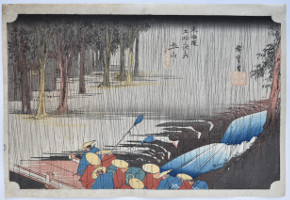
Click here to view image full size.
Tsuchiyama, haru no ame, “Tsuchiyama, Spring Rain.” Number 49 from the famous Tokaido gojusan tsugi no uchi, “The Fifty-three Stations of the Tokaido.” Published by Hoeido, c. 1833-4. Hiroshige travelled the length of the Tokaido as part of an official delegation in 1832 making sketches along the way. On his return he started work on the set eventually producing 55 prints. The first of the designs were published jointly by Hoeido and Senkakudo, but then Hoeido took over the production. Shows a daimyo’s cortege crossing the Tamura River. Tsuchiyama flourished because of its location at the entrance to the Suzuka Pass. However, in Meiji times, the town was bypassed by the railway because of the steep gradients here. This is the rare first edition.
Fine impression. Slight fading of seals, slight centre fold and minimal soil to left edge, otherwise very good condition. Signed Hiroshige ga.
Status: Sold
Utagawa HIROSHIGE (1797-1858)
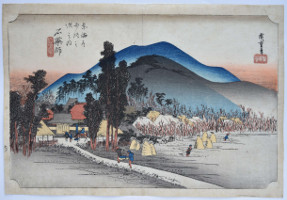
Click here to view image full size.
Ishiyakushi, number 44 from the Tokaido showing figures entering the village with others working in the fields. Ishiyakushi-ji Temple was seen on entering the village. From the famous Tokaido gojusan tsugi no uchi, “The Fifty-three Stations of the Tokaido.” Published by Hoeido, c. 1833-4. Hiroshige travelled the length of the Tokaido as part of an official delegation in 1832 making sketches along the way. On his return he started work on the set eventually producing 55 prints. The first of the designs were published jointly by Hoeido and Senkakudo, but then Hoeido took over the production. This is the rare first edition.
Fine impression. Slight fading of seals, slight centre fold and minimal soil to left edge, otherwise very good condition. Signed Hiroshige ga.
Status: Sold
Ichiryusai HIROSHIGE (1797-1858)
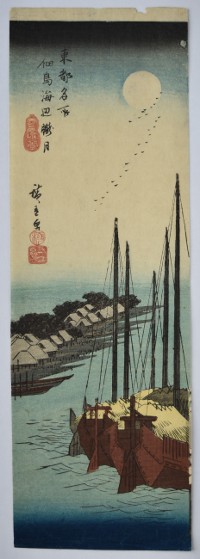
Click here to view image full size.
Spring moon at the shore of Tsukudajima. One of a set of chu-tanzaku prints published by Shogendo, c.1837. Tsukudajima was one of two islands at the mouth of the Sumida River. Originally a sandbar, it was reclaimed with earth and rocks and given its name by the first Tokugawa Shogun, Ieyasu, who invited thirty-three fishermen to live there in 1613 in order to provide fish for the rapidly expanding city of Edo. The fishermen came from Tsukudama near Osaka. And it was they who became the proprietors of what would become the Tsukiji fish market. It must have been popular during the late Edo period as a place to visit and view the boats from teahouses on the shore because there are many prints depicting the area, especially under a full moon.
Fine impression, colour and condition. Signed Hiroshige ga.
Status: Sold
Utagawa HIROSHIGE (1797-1858)
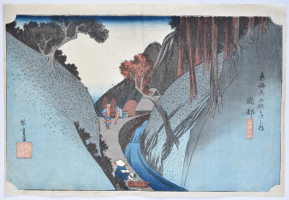
Click here to view image full size.
Okabe, Utsu no yama, “Okabe, Utsu Mountain.” Number 21 from the famous Tokaido gojusan tsugi no uchi, “The Fifty-three Stations of the Tokaido.” Published by Hoeido, c. 1833-4. Hiroshige travelled the length of the Tokaido as part of an official delegation in 1832 making sketches along the way. On his return he started work on the set eventually producing 55 prints. The first of the designs were published jointly by Hoeido and Senkakudo, but then Hoeido took over the production. Utsunoya Pass is just before Okabe. The pass is the scene of a Kabuki play by Mokuami Kawatake (1816-1893) where Jubei Itamiya kills and robs the blind Bun’ya. This is the rare first edition.
Fine impression. Slight fading of seals, slight centre fold and minimal soil to left edge, otherwise very good condition. Signed Hiroshige ga.
Status: Sold
Utagawa HIROSHIGE (1797-1858)
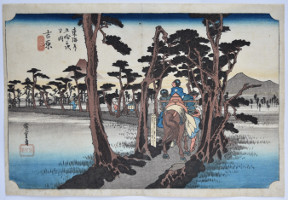
Click here to view image full size.
Yoshiwara, hidari Fuji, “Yoshiwara, Mount Fuji on the left.” Number 14 from the famous Tokaido gojusan tsugi no uchi, “The Fifty-three Stations of the Tokaido.” Published by Hoeido, c. 1833-4. Hiroshige travelled the length of the Tokaido as part of an official delegation in 1832 making sketches along the way. On his return he started work on the set eventually producing 55 prints. The first of the designs were published jointly by Hoeido and Senkakudo, but then Hoeido took over the production. After being destroyed by a tidal wave in 1680 Yoshiwara was rebuilt further inland from the sea. This is the rare first edition.
Fine impression. Slight fading of seals, slight centre fold and minimal soil to left edge, otherwise very good condition. Signed Hiroshige ga.
Status: Sold
Utagawa HIROSHIGE (1797-1858)
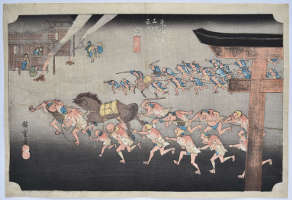
Click here to view image full size.
Miya, Atsuta shinji, “Miya, Festival of the Atsuta Shrine.” Number 41 from the famous Tokaido gojusan tsugi no uchi, “The Fifty-three Stations of the Tokaido.” Published by Hoeido, c. 1833-4. Hiroshige travelled the length of the Tokaido as part of an official delegation in 1832 making sketches along the way. On his return he started work on the set eventually producing 55 prints. The first of the designs were published jointly by Hoeido and Senkakudo, but then Hoeido took over the production. Miya was the largest station on the Tokaido. There were many inns catering for the pilgrims going to Ise and daimyo travelling to Edo. Shows the horse-driving festival held at the Shinto Atsuta Shrine, the Hama Gateway to the right. This is the rare first edition.
Fine impression. Slight fading of seals, slight centre fold and minimal soil to left edge, otherwise very good condition. Signed Hiroshige ga.
Status: Sold
Utagawa HIROSHIGE (1797-1858)
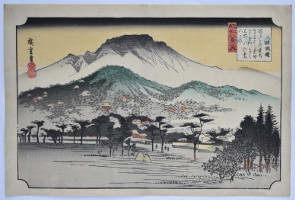
Click here to view image full size.
Mii no bansho, “Evening Bell at Miidera Temple” from an early set Omi hakkei no uchi, “Eight Views in Omi Province.” Shows the temple hidden amongst hills on the southern side of Lake Biwa. Miidera is the common name for the Onjoji, a temple of the Tendai sect, founded in 858. Published by Hoeido and Eikyudo in c. 1834-5. The “Eight Views” theme was derived (as so much else in Japanese art) from China and based on the Eight Views of Xiaoxiang paintings of the 11th century. The subject was transposed to Omi and then taken up by such artists as Harunobu , and later Hiroshige. It was also often playfully alluded to in sets of eight prints in mitate-e style.
Fine early impression and colour. Imperceptible centre fold, otherwise fine condition. Signed Hiroshige ga.
Status: Sold
Utagawa HIROSHIGE II (1829-1869)
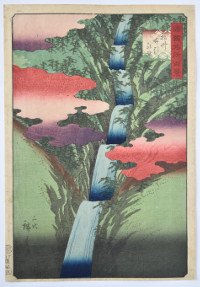
Click here to view image full size.
Sesshu Nunobiki no taki, “The Nunobiki Waterfall in Settsu Province,” from a set Shokoku meisho hyakkei, “One Hundred Famous Views in the Various Provinces.” The set published by Uoya Eikichi between 1859 and 1861 (this being 1859). He was the pupil of Hiroshige, given the name Shigenobu. After Hiroshige’s death he married his adopted daughter and became Hiroshige II. The couple were divorced in 1865. She went on to marry another pupil of her father’s – Shigemasa, who became Hiroshige III.
Superb impression and colour with extensive mica and woodgrain. Fine condition. Signed “The second” Hiroshige ga.
Status: Sold
Katsushika HOKUSAI (1760-1849)
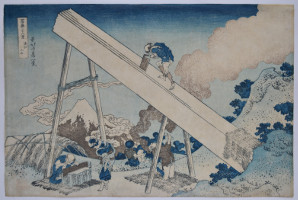
Click here to view image full size.
Totomi sanchu, “In the Totomi Mountains” from Hokusai’s most famous set Fugaku sanju-rokkei, “Thirty-six Views of Fuji.” The set published by Nishimuraya Yohachi c. 1830-33. Originally planned as a set of 36 prints, ten more designs were added. These are called the Ura-Fuji, “Fuji from the Other Side.” These designs have a black outline, while early impressions of the first 36 are printed with a blue outline changing to black on later editions. Shows lumbermen cutting a huge log while another, lower left, sharpens a saw watched by a woman with a child strapped to her back. This set was a considerable undertaking for the publisher, especially as the relatively new pigment berurin burau, “Berlin blue” was being used which was expensive.
Very good impression, colour and condition. Very full size. Signed Saki no Hokusai Iitsu hitsu.
Status: Sold
Utagawa KUNISADA (1786-1864)
Click here to view image full size.
Winter from a set of the four seasons showing Prince Genji and attendants in the snow-covered grounds of a palace. Published by Enshuya Hikobei, c 1849-50.
Fine impression and colour. Slight trimming, otherwise fine condition. Signed Ichiyusai Toyokuni ga.
Status: Sold
Utagawa HIROSHIGE (1797-1858) and Utagawa KUNISADA (1786-1865)
Click here to view image full size.
A triptych showing Mitsuuji, the romantic hero of the Inaka Genji (“A Rustic Genji”) accompanied by a beauty looking out across a snow-covered garden where a group of girls are building a giant snow rabbit. Hiroshige and Kunisada collaborated on a number of these Genji triptychs in the 1850s and this is one of the most charming. Published by Moriya Jihei of Kinshodo, 12/1854 (and therefore probably in anticipation of the following year, which was a Year of the Rabbit).
Very good impression, colour and condition. Signed Toyokuni ga and Yuki no kei oju, “Snow landscape by request” Hiroshige hitsu.
Status: Sold
Ichiryusai HIROSHIGE (1797-1858)
Click here to view image full size.
Tadasugawara no yudachi, “Evening Shower on the bank of the Tadasu River” from the early set Kyoto meisho no uchi, “Famous Views of Kyoto.” The set of ten masterpieces was published by Eisendo, c 1834. Shows figures running in the rain to get to the tea-houses which lined the banks here where the Kamo River and Takamo River joined.
Very good impression. The extremely rare first state of this print has the publisher’s seal in red in the upper left margin. This early state has the kiwame seal in left margin. This was removed on later editions and the seal after Hiroshige’s signature has the characters reversed white on red. Very good colour. Imperceptible centre fold, otherwise very good condition. Signed Hiroshige ga.
Status: Sold
Ichiryusai HIROSHIGE (1797-1858)
Click here to view image full size.
Kai Otsuki no hara, “The Otsuki Plain in Kai Province”. A meandering stream with flowers and pampas grass from Fuji sanjurokkei, “Thirty-six Views of Fuji” published by Tsutaya Kichizo, 1858. The set was started 5 months before Hiroshige’s death and early impressions were printed very carefully as a tribute to Hiroshige. One of the six best designs from the set.
Fine impression, colour and condition. Signed Hiroshige ga.
Status: Sold
Ichiryusai HIROSHIGE (1797-1858)
Click here to view image full size.
Ishiyama no shugetsu, “Autumn Moon at Ishiyama” from a set of prints Omi hakkei no uchi, “Eight Views in Omi Province.” Shows Lake Biwa with Seta Bridge and Mount Hira in the distance. To the left is the temple where Murasaki Shikibu wrote her famous Tales of Genji. Published by Takenouchi, c. 1834-5. A guarantee label and seal au verso from the now deceased dealer M. Nakazawa.
Fine impression: There is a curious feature on this print in that the blue sky block is invariably printed short of the mountain, top left, giving a white gap around the mountain. This is one of the few impressions I have seen where it is barely visible. Fine colour. Slight edge soil, otherwise very good condition. Signed Hiroshige ga.
Status: Sold
Ichiryusai HIROSHIGE (1797-1858)
Click here to view image full size.
The year-end festival, Toshi-no-ichi, at Asakusa, Edo. This Buddhist temple was dedicated to bodhisattva Kannon. From the set Rokuju yoshu meisho zue, “Famous Places in the Sixty-odd Provinces.” Published by Koshimuraya Heisuke between 1853-1856 (this being 1853). Thousands gathered at this time of year to pray one last time and to purchase New Year goods.
Extremely fine, early impression. Probably a variant first edition: without bokashi clouds as on Pulverer’s impression, but with the purple block partly printed over the trees left and right which is lacking on Pulverer’s. This maybe the earliest state. Fine colour and condition. Signed Hiroshige ga.
Status: Sold
Ichiryusai HIROSHIGE (1797-1858)
Click here to view image full size.
Wakasa, gyosen karei ami, catching flatfish in Wakasa Province. From the set Rokuju yoshu meisho zue, “Famous Places in the Sixty-odd Provinces.” Published by Koshimuraya Heisuke between 1853-1856 (this being 1853). This province was famous for its flatfish caught in the offshore waters and was considered a winter delicacy.
Fine, early impression. Fine colour and condition.Signed Hiroshige ga.
Status: Sold
Ichiryusai HIROSHIGE (1797-1858)
Click here to view image full size.
Bingo Abumon Kannondo. The temple of Kannon at Abumon, Bingo Province. From the set Rokuju yoshu meisho zue, “Famous Places in the Sixty-odd Provinces.” Published by Koshimuraya Heisuke between 1853-1856 (this being 1853).
Fine, early impression. The earliest states have a cloud printed top left (as here). Very good colour. Slight centre fold and trimmed close, otherwise good condition. Signed Hiroshige ga.
Status: Sold
Ichiryusai HIROSHIGE (1797-1858)
Click here to view image full size.
Mitake from Kisokaido rokujukyu-tsugi no uchi, “Sixty-nine Stations of the Kisokaido.” The set of seventy prints was first published by Hoeido in 1835 with Eisen, but in 1837 Hiroshige took over and completed the series with the publisher Iseya Rihei (Kinjudo). The conjecture is that Hiroshige was the better known and more commercial artist, reinforced by the fact that Eisen’s name was removed from the designs already published. Hence, only the first editions have his signature on those prints. Shows a post station near to the famous Gankoji Temple. The inn and teahouse is advertising lodging.
Fine, very early impression. Fine colour and condition. Signed Hiroshige ga.
Status: Sold
Ichiryusai HIROSHIGE (1797-1858)
Click here to view image full size.
Tarui from Kisokaido rokujukyu-tsugi no uchi, “Sixty-nine Stations of the Kisokaido.” The set of seventy prints was first published by Hoeido in 1835 with Eisen, but in 1837 Hiroshige took over and completed the series with the publisher Iseya Rihei (Kinjudo). The conjecture is that Hiroshige was the better known and more commercial artist, reinforced by the fact that Eisen’s name was removed from the designs already published. Hence, only the first editions have his signature on those prints. Shows a daimyo’s cortege entering the station. On either side the villagers can be seen deferentially kneeling. This print is one of the few designs to show prints for sale. In this case on either side of the road, the shops doubling as teashops. The publisher’s mark Kinjudo can be seen on the left-hand shop.
Very good impression, colour and condition. Signed Hiroshige ga.
Status: Sold
Ichiryusai HIROSHIGE (1797-1858)
Click here to view image full size.
Shiba Akabane no yuki, “Snow falling at Akabane in Shiba.” From a Toto meisho “Famous Sights of the Eastern Capital” set published by Kikakudo (Sanoki), the seal in red in right margin, c. 1832-35. There is confusion over how many prints belong to this series: The original set of twenty-one designs seem to have been extended to fifty-five in c. 1839-42. Shows the Akabane Bridge with the Zojo-ji Temple between trees above. To the right is Chancellor Arima’s mansion and above a tall fire-tower.
Fine, early impression. A very difficult design to find in early state. Later editions have the black seal of Sanoki in the right margin. Another first edition is in the Clarence Buckingham collection, The Art Institute of Chicago (1925.3464). A further interesting detail is that a block was specifically chosen with a wavy grain to print the water. Very good colour and condition. Signed Hiroshige ga.
Status: Sold
Katsushika HOKUSAI (1760-1849)
Click here to view image full size.
A poem by Abe no Nakamaro from the unfinished set Hyakunin isshu uba ga etoki, “Hundred Poems Explained by the Wet Nurse.” Twenty seven prints known with extant drawings for another sixty two. Published in 1835 by Nishimuraya Yohachi (who issued five) who then sold the blocks to Iseya Sanjiro. Shows the poet on a mount with Chinese soldiers waiting to take him away and imprison him. An unconventional interpretation of the poem which has Nakamaro left in a high pagoda to starve to death for attempting to steal the secrets of the Chinese calendar. He gazes at the moon (seen here reflected in the sea) and asks if it’s the same moon as that rising over his homeland – Japan.
Fine impression, colour and condition. Signed Zen Hokusai with Manji seal. As with others in this set, the signature is near the extreme edge and is often trimmed off.
Status: Sold
Ichiryusai HIROSHIGE (1797-1858)
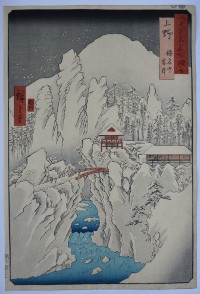
Click here to view image full size.
A snow scene showing the dramatic landscape around Mount Haruna: Kozuke, Haruna-san setchu, “Snow on Mount Haruna in Kozuke Province.” Shows the volcanic mount – one of three major mountains in the province – with Haruna Temple in the centre. The building housed a statue of a thousand-armed kannon, bodhisattva of mercy. One of the best designs from the set Rokuju yoshu meisho zue, “Famous Places in the Sixty-odd Provinces.” The set published by Koshimuraya Heisuke between 7/1853 and 8/1856 (this being 1853).
Fine, early impression. The most difficult print from the set to identify in the first edition. Most designs in the set have distinctive features in the first state such as variegated cartouches or extra gradation. The only indication here is that the sub-cartouche should have a brown-red colour. Fine colour and condition. Signed Hiroshige ga.
Status: Sold
Ichiryusai HIROSHIGE (1797-1858)
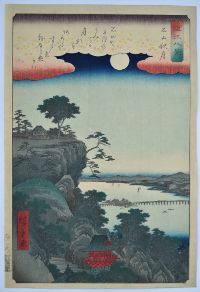
Click here to view image full size.
Ishiyama shugetsu, “Autumn Moon over Ishiyama Temple” from the vertical Omi hakkei no uchi, “Eight Views of Omi” set published by Takeuchi Magohachi and Yamamotoya Heikichi in 1857.
Very fine impression of the first edition. Fine colour and condition. Signed Hiroshige ga.
Status: Sold
Utagawa HIROSHIGE II (1826-1869)
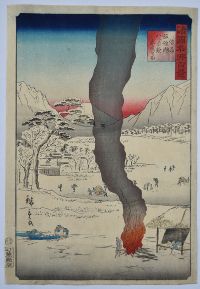
Click here to view image full size.
Shinshu Suwa-ko yatsume akauo wo to (ru). Shinshu (Shinano) Province from the “Hundred Views of Famous Places in the Provinces.” An uncompleted set of 81 prints published by Uoya Eikichi between 1859 – 1861 (this being 1860). A winter scene showing figures catching lampreys, eels and red rockfish in Lake Suwa. The lake was unusual in having warm currents beneath the ice, even in mid winter.
Fine impression of the first edition. Fine colour. Very slight edge soil, otherwise fine condition. Signed Hiroshige ga.
Status: Sold
